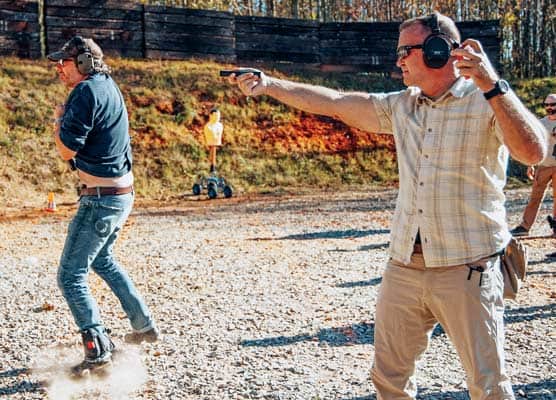NAA's Ranger II
.22 Magnum Back-Up Moxy
After many years of making their beautiful little updated version of the solid-frame spur-trigger revolver, they decided to try something different. About seven years ago, Ken Friel and the design team at North American Arms made their first tiny top-break, and called it the “Ranger.”
In traditional design, the latch for opening the barrel unit was T-shaped and pivoted on the barrel extension. The one on the original Ranger was slightly different, but worked the same way, engaging posts on the frame. This was quite strong enough for the cartridges used. The original Ranger was sort of an experiment, and only around 500 were made.
The new version, arriving in late 2017, is named “Ranger II” and the main change was the barrel latch. For this, they went all the way back to the mid-1870s and a design by U.S. Army Colonel George Schofield. He showed it to Smith & Wesson, and they liked it. So did the military. From 1875 to 1877, the Schofield latch was added to the .45 S&W Model 3 revolver, a U.S. military issue of that time.
Both stronger and easier to operate, the Schofield latch pivoted on the frame, engaging a solid projection on the barrel extension. To open, it’s simply tipped toward the rear. In mechanical principle, it’s essentially the same as the one used on the old British Webley, but without the left-side thumb-piece of that one.
On the NAA Ranger II, the top front of the latch has cross-serrations for good thumb-contact. It’s also cut to be the square-picture rear sight. The brass front sight is a simple post with a rounded top. In the full-down position, the hammer bears on the latch. For opening, the hammer must be set on its first notch.
As the good NAA user’s manual will quickly remind you, this hammer position is not intended as a safety. For fully-loaded safe carry, you carefully let the hammer all the way down into one of the deep notches in the edge of the cylinder, between two of the chambers. When it’s in that position no impact on the hammer spur would fire it.
Critical Changes
The Ranger II is chambered for .22 Magnum (.22 WMR). An extra cylinder in .22 Long Rifle is available, but it must be pre-ordered, as it has to be precisely fitted. The length of the .22 WMR cartridge influenced the ejector design in the new Ranger. On the old version, when the barrel unit was opened, the ejector would rise, then snap back into place.
On the Ranger II, when the barrel unit is about two-thirds open, the ejector slightly lifts the cases for easy removal. The ejector does not snap back in, it just retreats as the unit is tipped rearward for loading. With the considerable length of the .22 WMR cartridge, this was a wise decision.
Mention of the principal chambering reminds me to note the .22 WMR was originally a rifle round, and thus the powder used had a slower burning rate. Used in a handgun, those loads will have a marvelous muzzle-flash, and will lose some velocity. Several of the ammo companies now offer .22 Magnum loads specifically for handguns. So, if you get a Ranger II, be sure to look for those.
Shooting Thoughts
From the description of the sights, you’ll already know the Ranger II isn’t a serious target gun. Even so, at 15 yards, with a two-hand hold, it delivered some well-centered 3″ and 4″ groups. Closer in, with a little practice, you could easily nail a rat — or its human equivalent — in the right place.
So, yes, the Ranger II deserves consideration as second or third back-up carry. Its numbers also qualify it. The unloaded weight is 6.9 oz. Overall length, 5.1″, height, 2.81″ and width right at 1.6″. Barrel length is 1.6″ and the tiny cylinder holds five rounds. At close range, in a serious situation, the last number mentioned should be quite adequate. The .22 Mag round is no sissy.
In case some of you big-bore guys are sneering at this last remark, I’ll briefly add a case described to me by a California attorney a few years ago. A woman was attacked by a large man and dragged off the street into a park area. She managed to get one of the original solid-frame NAA revolvers from her purse. She positioned it, essentially, up his nose, and pressed the trigger. His ticket was canceled, instantly and permanently. Well done.
Okay, where were we? The Ranger II is stainless steel, with a fine matte finish. Internally and externally, the precise fitting of parts is awesome. Gauging weight of pull on a spur-trigger is difficult, but my educated trigger finger says it’s a crisp 5 lbs. The shape of the laminated-wood grips gives a good hold, and the hammer is easy to thumb back.
In this day of plastic and aluminum cases, the one the Ranger II comes in is notable. It’s steel, with a key lock. For the basic Ranger II, MSRP is $479. If you also go for the extra .22 LR cylinder, it’s $574.
With this degree of beauty, quality, and precision, it’s worth it — even at full price.
For more info: https://www.northamericanarms.com; NAA, Ph: (800) 821-5783










